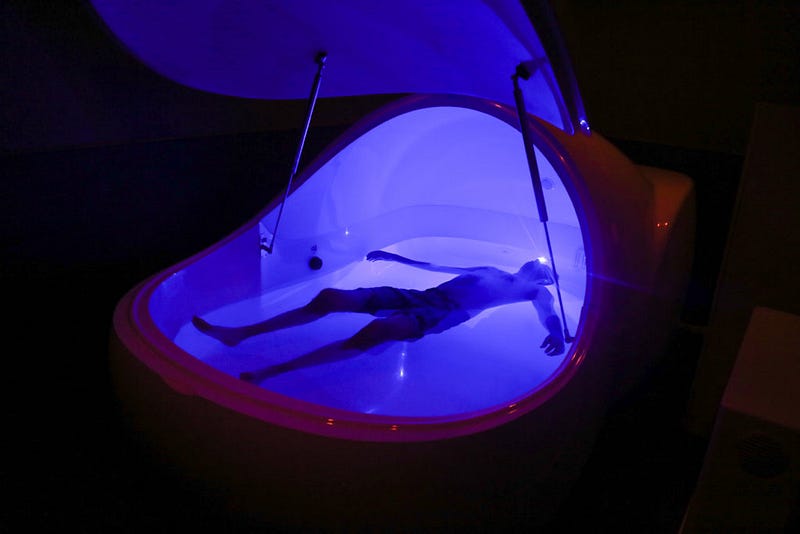Frequent Floater
Flotation therapy offers a deep meditative state and physical healing
STORY BY NICK BELCASTER | PHOTOS BY BEATRICE HARPER
(Above) David Pangborn, graduating from Western with his Masters degree in music composition, floats serenely in a deprivation tank at Still Life, in Bellingham.
A white womb emanating a soft purple glow takes up the majority of the room. Bobbing like a cork, I lay back in an Epsom salt bath. There is no sound, save for the heartbeat. There is no light. Even touch is fading now. I may have been puzzled by the term “sensory deprivation” at first, but now it’s really got a hold.
A trendy method that could interest in those who meditate or receive acupuncture, sensory deprivation or “flotation therapy” has been building steam across North America since the 1980s. Focused on limiting the stimuli the brain receives, the goal is clear: relax as deeply as possible.
At any float studio across the country the ritual is fairly similar. I’m instructed to begin with a cool shower to clean the body, then enter the tank nude and pull the door closed. The tanks themselves can vary slightly from model to model, but this one allows for a full fingertips-to-toes stretch. The lights tilt out, and there’s nothing more to do now other than relax. I’m not sure what I’m expecting to get out of this.
As owner of Afloat Float Studio in Bellingham, Washington Dan Martin most often sees two types of people walk through his door: those who are looking for physical pain relief, and those who are looking for mental tranquility. With a M.S. in Psychology and an interest in consciousness, it’s easy to say that Martin’s got floating on the brain.
Martin’s interest in meditation and mindfulness, a mental state that directs focus on only the present moment, first led him to floating, but eventually to offering use of the float tank to the general public.
Martin says that many may ask themselves, “What does floating in a dark bathtub have to do with mindfulness?”
There is a state of physical calm, Martin says, that can allow people to achieve mindfulness. Flotation therapy is one avenue into this calm, stripping away most of the sensory input to the brain and allowing it to focus much more deeply.
Originally known as isolation tanks, the devices were pioneered in 1954 by American psychoanalyst and neuroscientist John C. Lilly, in order to test the effects of sensory deprivation. Today these tanks can vary widely, but all adhere to these main requirements: a sound and lightproof tank, which is filled with skin-temperature salt water to increase buoyancy.
Preparation of the tank is no small feat. Whereas an Epsom salt bath in your home might use 2 pounds of the flotation aid, most float tanks use upward of 800 pounds. Martin’s tank utilizes a multistep filtration system with ultraviolet light to entirely cleanse the solution between clients.

Back in the tank, the power of flotation therapy is really starting to show itself.
Because the water is kept at 93.5 degrees — skin temperature — it’s getting harder to differentiate between my body and the water. The position of limbs isn’t really registered, and the feeling could just as well be floating on air.
And it isn’t only physical. Behind my eyelids, golden ripples are shimmering back and forth, like being suspended beneath a pool of water, someone dragging their fingertips across its surface. It may only be 30 minutes into an hour-long session, but time doesn’t mean much anymore.
Martin, of course, has an answer for this. Within your brain is a portion known as the reticular activating system, or RAS, which upon becoming inactive the brain ceases to sense incoming sensory stimuli. From here it’s like an echo chamber, and some people can experience visualizations. This is where the common phrase “sensory deprivation tank” comes from, though Martin corrects this by calling it sensory attenuation — you can’t entirely cut off your senses in the tank.
Although Martin can recall his most profound float — a five-hour marathon that was highlighted by visuals and a stripping of the self — he finds that his overall time floating has built up a much more deep understanding of himself.
“I think the tank can be more profound than just one-time experiences,” Martin says. “I hold [the tank] responsible for showing me these new states of mindfulness.”
Many chiropractors, massage therapists and acupuncturists in town recommend their clients to Martin, and across town one massage therapist has brought the therapy directly under her practice.
Shannon and Tim Fuller are owners of Still Life Massage and Float; they decided to bring float tanks into the business after hearing about the practice from a friend and experiencing it firsthand.

Shannon’s introduction to floating was the first time where she felt her brain could just turn off — not an easy task for someone who says her mind is always racing. A profound click occurred, and the therapy became something she could see integrating into her existing massage practice.
Tim was not so easily convinced.
“I was the guy who was so skeptical about this,” Tim says. “I actually brought a book thinking there is no way I could lay in water for an hour, I’ll probably last 20 minutes and come out.”
Tim didn’t end up needing that book. His first float left him amazed with the experience and fully convinced of the therapy’s potential. The pair purchased two pod-style float tanks a year and a half ago — the same pod I’m currently suspended in — and have been helping many float since then.
Because Still Life began as primarily offering massage, the duo focus heavily on the body benefit flotation therapy can provide. The weightlessness provided by the tanks allows the body to loosen up, Tim says, and in the time that they have been offering the service, many have been attracted to the combination of therapies.
“The kinds of people that are curious about it come from all spectrums,” Shannon says. “There is no age group we found to be more interested.”
Tim tells the story of his favorite client: an older man who spent his life as a bull rider and football coach suffering from back pain, but because of his age, surgery was out of the question. After trying float therapy, Tim says the man was able to walk out of the center without the cane he came in on, saying “I don’t have the vocabulary in me to tell you how good I feel right now.”
It may be difficult to put a price on ultimate relaxation, but it seems most float centers agree on roughly the dollar-per-minute figure. One hour is the average commercial length, though Tim says that some centers around the country are experimenting with the flotation long haul: 2-hour- and up to 24-hour-long sessions.

As an hour comes to a close, soft music begins to play in the tank, signaling that the journey is over. A shower to rinse the salt off, towels to dry, everything is set out to ensure a gradual re-entry into the world.
In a gentle euphoria, I sit in a chair set out specifically for reflection. The window view looks out over the harbor, with hundreds of boats, gently bobbing in the wake.
